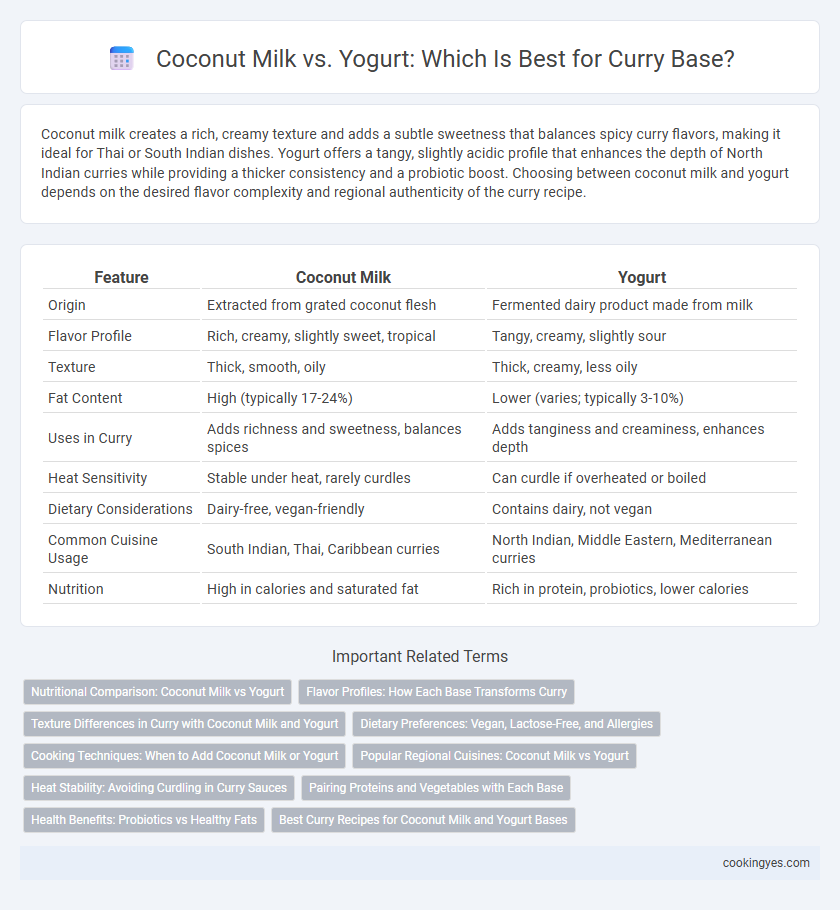Coconut milk creates a rich, creamy texture and adds a subtle sweetness that balances spicy curry flavors, making it ideal for Thai or South Indian dishes. Yogurt offers a tangy, slightly acidic profile that enhances the depth of North Indian curries while providing a thicker consistency and a probiotic boost. Choosing between coconut milk and yogurt depends on the desired flavor complexity and regional authenticity of the curry recipe.
Table of Comparison
| Feature | Coconut Milk | Yogurt |
|---|---|---|
| Origin | Extracted from grated coconut flesh | Fermented dairy product made from milk |
| Flavor Profile | Rich, creamy, slightly sweet, tropical | Tangy, creamy, slightly sour |
| Texture | Thick, smooth, oily | Thick, creamy, less oily |
| Fat Content | High (typically 17-24%) | Lower (varies; typically 3-10%) |
| Uses in Curry | Adds richness and sweetness, balances spices | Adds tanginess and creaminess, enhances depth |
| Heat Sensitivity | Stable under heat, rarely curdles | Can curdle if overheated or boiled |
| Dietary Considerations | Dairy-free, vegan-friendly | Contains dairy, not vegan |
| Common Cuisine Usage | South Indian, Thai, Caribbean curries | North Indian, Middle Eastern, Mediterranean curries |
| Nutrition | High in calories and saturated fat | Rich in protein, probiotics, lower calories |
Nutritional Comparison: Coconut Milk vs Yogurt
Coconut milk is rich in medium-chain triglycerides (MCTs) and provides a high amount of saturated fats, making it a calorie-dense option with essential minerals like manganese and copper. Yogurt offers a high protein content along with probiotics that support digestive health, and it is lower in fat and calories compared to coconut milk. Both ingredients provide unique nutrients, with coconut milk favoring energy-rich fats while yogurt delivers beneficial bacteria and calcium for bone health.
Flavor Profiles: How Each Base Transforms Curry
Coconut milk creates a rich, creamy texture with a subtle sweetness and tropical notes that enhance the curry's depth and mellow spiciness. Yogurt adds a tangy, slightly acidic flavor that brightens the dish and introduces a refreshing contrast to bold spices. The choice between coconut milk and yogurt significantly influences the curry's final taste, balancing richness with either sweetness or tartness.
Texture Differences in Curry with Coconut Milk and Yogurt
Coconut milk creates a rich, creamy texture with a smooth and velvety consistency that enhances the curry's body and mouthfeel. Yogurt adds a slightly tangy flavor with a thicker, more curdled texture that can make the curry feel heavier and less uniform. The choice between coconut milk and yogurt impacts the overall creaminess and thickness, influencing the final dish's sensory appeal.
Dietary Preferences: Vegan, Lactose-Free, and Allergies
Coconut milk serves as a vegan and lactose-free alternative to yogurt in curry bases, accommodating those with dairy allergies or lactose intolerance. Yogurt provides a tangy flavor and probiotics but is unsuitable for vegans and individuals sensitive to lactose or dairy proteins. Choosing between coconut milk and yogurt depends on dietary restrictions and desired taste profiles in curry preparation.
Cooking Techniques: When to Add Coconut Milk or Yogurt
Coconut milk should be added towards the end of cooking to prevent curdling and preserve its creamy texture in curry, especially in dishes simmered over low heat. Yogurt, on the other hand, requires tempering and is best incorporated earlier in the cooking process to blend smoothly and enhance the curry's tangy flavor without causing separation. Understanding these techniques ensures a rich, velvety curry base with balanced flavors and ideal consistency.
Popular Regional Cuisines: Coconut Milk vs Yogurt
South Indian and Thai curries predominantly use coconut milk, which imparts a rich, creamy texture and a subtly sweet flavor that balances spicy and aromatic spices. In contrast, North Indian and Middle Eastern curries often utilize yogurt as a base, offering a tangy, thick consistency that tenderizes meat and enhances depth of flavor. Both bases influence the regional palate and texture, with coconut milk lending a smoother, tropical undertone, while yogurt provides a sharp, fermented robustness essential to many traditional recipes.
Heat Stability: Avoiding Curdling in Curry Sauces
Coconut milk offers superior heat stability compared to yogurt, reducing the risk of curdling when simmered in curry sauces. Yogurt, with its higher protein content, tends to separate and curdle under high heat, especially if added too early during cooking. Using coconut milk ensures a smooth, creamy texture even during prolonged cooking or at higher temperatures common in many curry recipes.
Pairing Proteins and Vegetables with Each Base
Coconut milk creates a creamy, slightly sweet curry base that pairs exceptionally well with seafood, chicken, and vegetables like sweet potatoes, eggplants, and bell peppers, enhancing their natural flavors. Yogurt-based curries offer a tangy, rich profile perfect for pairing with tender cuts of lamb, chicken, and vegetables such as spinach, cauliflower, and tomatoes, balancing their earthy and robust qualities. Each base influences the texture and flavor absorption of proteins and vegetables, making the choice crucial for achieving harmonious, well-rounded curry dishes.
Health Benefits: Probiotics vs Healthy Fats
Coconut milk provides rich healthy fats, particularly medium-chain triglycerides (MCTs), which support energy metabolism and heart health. Yogurt offers probiotics that enhance gut health and boost the immune system by promoting beneficial bacteria in the digestive tract. Choosing between coconut milk and yogurt as a curry base depends on prioritizing either heart-healthy fats or digestive probiotics for overall wellness.
Best Curry Recipes for Coconut Milk and Yogurt Bases
Coconut milk creates a rich, creamy texture with a subtly sweet flavor, ideal for Thai and South Indian curry recipes like Thai Green Curry and Kerala Fish Curry. Yogurt offers a tangy, slightly acidic base that enhances Indian dishes such as Chicken Tikka Masala and Lamb Curry, adding depth and balancing spices. Both ingredients influence the curry's consistency and flavor profile, allowing chefs to choose based on desired taste and authenticity.
Coconut milk vs Yogurt for curry base Infographic

 cookingyes.com
cookingyes.com